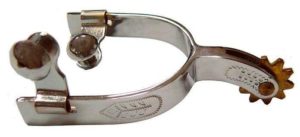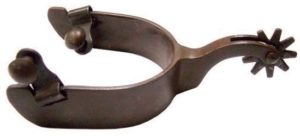 Spurs are a tool that is used primarily for lateral movement left and right and suppling your horse’s body.
Spurs are a tool that is used primarily for lateral movement left and right and suppling your horse’s body.
The precise placement of a spur on a horse’s body can induce him to move different parts of his body: his shoulder, his rear, his rib cage or lift his ribs. Spurs are an extension of your leg. If your horse has a tendency to lean on your leg when asked to move around, a spur acts as a reminder that ignoring you has consequences. Quickly your leg yields and body movement requests will become much more subtle and your horse’s compliance elevated to a new level of performance.
Initiating a movement starts with rotating your toe out and the heel toward the horse’s body. The length of the shaft dictates how quickly your spur begins to touch him. Longer shanks make contact with less turn. Shorter shanks take more effort and touch later. Cuing him should be as easy as touching the cue areas subtly (touching, “feathering” not jabbing or stabbing). Spurs are used to pressure him one direction or another and/or to supple him to bend in a turn or pick up his rib cage but NOT usually for speeding up unless in an emergency or when re-sensitizing a “dead-sided” horse.
It goes without saying that if your horse is not used to spurs, it is your responsibility as a trainer to introduce them thoroughly and gently. You can start on the ground (details below). Or you can start by wearing them, but if your seat is not balanced or you tend to clench or be jerky, now is not the time to introduce spurs under saddle.
Start on the ground as was explained in the lesson for introducing leg cues.
Substitute the spur (in your hand) for your heel.
Know the pressure points for leg cues. To reiterate:
Close to the front cinch will cue him to move his front quarters away from the pressure.
Where your leg naturally hangs is considered the middle. Pressing there will move your horse’s rib cage over, away from the pressure as in a side pass.
Behind the cinch, more in the area just in front of the back cinch will move your horse’s hind quarters over.
Using your spur in your hand, begin to lightly touch, then (if necessary) slowly, steadily roll and press the area he understands already. As soon as he responds with the proper step, relieve the pressure and allow him to rest to think about it. (Review Release Training).
If he is ignoring the spur, use your wrist to “roll” the rowel up his side a couple of inches – more firmly. Repeat until he is moving to the lightest touch from the spur rowel – a feather-light roll or touch. Change areas and repeat.
This training should be fairly quick, as he already knows the pressure points for his 5 body parts and the maneuvers rerquested at each point. He just needs to get used to the feel of the “pointed” spur vs. your rounded heel. The spur should not be “sharp” or painful, but firm (and steadily uncomfortable if necessary). As light a touch as possible but as firm as necessary to get him to move away from the pressure.
AFTER a trained horse has adjusted to the feel of a spur on the ground, it can be used under saddle to pinpoint the precise body area used for your request. It is more exact and can be more forceful than your rounded heel.
A spur can also be used to reinforce leg cues that a horse is not respecting. As with a bit, the spur is not engaged unless the horse begins to lay down on the job – to show you a lack of respect for the leg cue. At that point, the spur can be used to remind him that your leg does have a consequence if he fails to respond quickly. However, it is used as a reminder only. He will only be as responsive to your leg as the lightest pressure you use. If you constantly “nag” with a spur your horse will become dull to the cues and require constant babysitting to perform.
A spur is used only for cueing body maneuveres or suppling his response. It is NOT used to speed up. Cowboy movies are not a good example.
Types of Spurs

You may notice that the type of spur in the left picture has a neck that points down. How long the neck of the spur is and what direction is points are important as they relate to how much equipment is between your heel and the horse, where you want to touch his body, and whether your want to urge left, right, pick up his ribs etc.
Spurs whose neck points down (drop-shank spur) are generally used by shorter legged riders who want to contact the horse further down on the rib than they can reach easily. Long-legged people use a spur whose shank points up so that they can contact the horse with the shortest reach.
